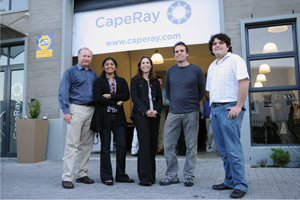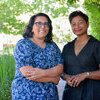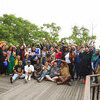Ray of light from new imaging spinoff
20 August 2010 | Story by Newsroom New paths: Emer Prof Kit Vaughan (far left) with his CapeRay team in front of the company's offices - software engineer Susan Alexander, business manager Natasha Steele, senior design engineer Michael Evans and electronics engineer Benjamin Lunsky.
New paths: Emer Prof Kit Vaughan (far left) with his CapeRay team in front of the company's offices - software engineer Susan Alexander, business manager Natasha Steele, senior design engineer Michael Evans and electronics engineer Benjamin Lunsky.
The skeletal prototype measures in at about half a metre, and with wires and bits hanging loose, it appears too mussy for the world-beating technology that its inventors are confident it will become.
But as the flagship product of new medical-imaging company CapeRay, that's exactly what founder and CEO, UCT's Emeritus Professor Kit Vaughan, has in mind for it. CapeRay and the prototype stem from 11 years of research at the Medical Research Council/UCT Medical Imaging Research Unit, and are a spinoff from UCT venture, African Medical Imaging (Pty) Ltd.
And soon, within the next 12 months, the still unprepossessing contraption will blossom into a world first - a "dual-modality" technology that will combine both X-ray and ultrasound images to produce the most detailed and sharpest breast-cancer-detecting images yet. (According to Vaughan, X-ray mammography combined with ultrasound will push sensitivity up to around 95%, a marked improvement from standard mammography.)
But CapeRay has been working on more than just its technology. Over the past year, Vaughan and co - including two UCT graduates, senior design engineer Michael Evans and electronics engineer Benjamin Lunsky - have set up a spiffy office in Westlake and have gone through a rigorous branding and marketing exercise.
"We had to position ourselves in the market as a serious competitive manufacturer of medical imaging technology," said Vaughan, who retired from most of his academic duties to head up CapeRay.
The company is also a feather in the university's cap, as most of the underpinning research was done - and funding sourced - at UCT. In addition, the company serves as a blueprint for other innovators here.
"The great thing is that it presents a role model," says Dr Andrew Bailey, intellectual property manager with UCT's Research Contracts and Intellectual Property Services. "It shows what can be done and how, even if it does take time."
 This work is licensed under a Creative Commons Attribution-NoDerivatives 4.0 International License.
This work is licensed under a Creative Commons Attribution-NoDerivatives 4.0 International License.
Please view the republishing articles page for more information.










